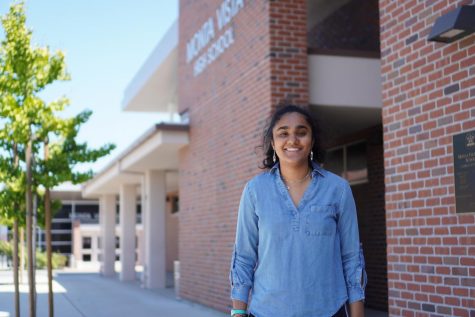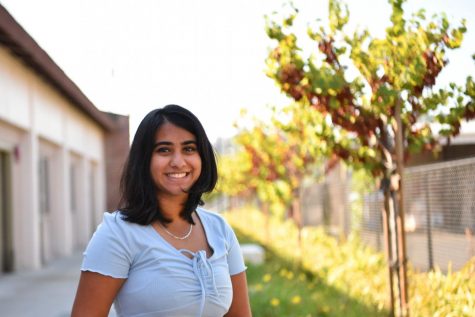Athletic conditioning
Exploring the impact of COVID-19 on team conditioning
September 24, 2020
Due to COVID-19, the Santa Clara County Public Health Department placed restrictions on FUHSD athletics and activities. MVHS sports teams were allowed to practice over the summer but only if they followed certain guidelines such as going through pre-workout screening, having workout “cohorts” of 12 or fewer people, wearing masks when near each other and maintaining social distancing. From July 13 to 31, the Football, Girls Basketball and Cross Country teams held practices multiple days a week while following these guidelines, until the continuation of these activities was suspended.
Junior and Varsity Cross Country runner Ellie Hsu explains that the team had two practices a day, one at 7 a.m. and one at 6 p.m., in which runners could follow certain workouts socially distanced, that their coach published on the team’s website. Hsu explains that due to the social distancing guidelines, runners have to do their workouts and go on their runs individually instead of with teammates, limiting connection among both returning members and new freshmen runners. Hsu notes that this causes the freshmen runners to miss out on some of the social aspects of being on the Cross Country team.
“Mentally, it’s a little bit less encouraging not to run with your team and to run alone, [having] to push yourself instead of being around all your friends,” Hsu said. “It’s really a lot harder to talk to each other. That’s hindered a section of the freshmen the most. The rest of us know each other pretty well — we can text each other. But we don’t know [the freshmen] — we can’t interact with [them] as much and talk to them.”
Varsity Football Head Coach Ceazar Agront highlights that for the football team, the summer practices looked very different compared to previous years, due to the team not being able to lift weights and use other equipment. According to Agront, the team focused on plyometric exercises — where muscles exert force in quick, short intervals — running and other hands-off approaches to football. While Agront says that his players initially felt down about not being able to play contact football and conduct other normal exercises, he notes that as these conditioning practices continued, they became more motivated to put in the work.
“They were really excited, back in March prior to [the restrictions], and so not [having] a little taste or any kind of [regular] practice was hard for them,” Agront said. “But once they saw my workout plan and how I was integrating the new system that I was running, they all got motivated. They surprised me because they seem more hungry than I’ve ever had a team before. I think that they went from more of [a] carefree [and] having fun type of setting to, it’s all business when they’re here, because they want to make the most with the time they got.”
Senior and Varsity Football player Shreyas Deshpande agrees, believing that these lighter practices have also brought in newer members who are more willing to commit to the team.
“It actually surprised me that this year, I’m seeing a lot of new faces [working with the team] than I have seen in the past year,” Deshpande said. “I feel with football, it’s really easy to get intimidated … and some [new members] can leave [or] slack [off]. But this year, I feel since [workouts are] easier, people are more determined to stay connected. There’s a lot of new freshmen and there’s even [some] [upperclassmen] who [have] decided to play. It’s actually worked to our [team’s] benefit in that sense.”
Similar to the football team, the Girls Basketball team focused on socially distanced stationary exercises, mile runs and various drills on footwork. Senior and Varsity player Eshani Patel notes that even with these distancing guidelines, being able to see her teammates from far away was enough to make the workouts effective.
“It was really helpful to get out there,” Patel said. “[I feel that] when you’re with your team you’re a lot more motivated and there are other people pushing you. People were committed because [they were] pushed by [our] team. [For example], even though we can’t physically give each other high fives, we’re still encouraging each other.”
Though Patel feels that members of the Girls Basketball team were fully committed during conditioning, Hsu feels differently. She says that the Cross Country team has had trouble with motivation due to the postponement of their fall season to winter, which was announced by the California Interscholastic Federation (CIF) on July 20.
According to Hsu, this led some runners to question what their practice is leading up towards if the pandemic continues and their winter season gets postponed as well. However, Hsu adds that since the school closures in March, the team has invited multiple Zoom guest speakers in an attempt to maintain engagement. Ranging from motivational speakers to pro runners and athletes, they have helped cultivate the team’s perseverance and keep up morale. Hsu says that her favorite speaker was long distance American runner Desiree Linden because of her professional running background.
Hsu expresses that these COVID-19 restrictions and online workouts have put into perspective how much teams like Cross Country rely on camaraderie and bonding among teammates, rather than just being able to practice events alone.
“The best part of being on Cross Country is the people, talking to everyone and the bond you form over running,” Hsu said. “You’re definitely disconnected from everyone [online] — it’s a lot different than just seeing each other every single day and [talking] about the smallest things… For the most part, a part of me was always very focused on my own goals as a runner and I was a little bit self centered on my own improvement. But now I realize that a lot of Cross Country is the team and it’s not just running.”
After the suspension of practice on July 31 due to increases in COVID-19 cases in the county, teams halted conditioning — Football and Girls Basketball were advised to continue working out on their own, and Cross Country ran individually and conducted workouts over Zoom.
However, on Aug. 31, Athletic Director Nick Bonacorsi issued a statement on Instagram (@mvathletics) that athletic teams can conduct small cohort conditioning starting Sept. 14. Despite teams like Girls Basketball and Football being limited to non-contact workouts, Deshpande says that this conditioning time has allowed teams to focus more on other aspects of playing their sport.
“[These restrictions] really do open up our mind as to how much more we can put into football, because it’s giving us that extra time to start learning how to play football off the field,” Deshpande said. “At the end of the day, it’s not all just physical work … [we can] focus on technique or football IQ, watching plays, memorizing things and learning the ins and outs of football rather than practicing.”
Moving forward, as athletic teams plan to start or resume their restricted conditioning, Agront hopes that the football team will be able to start using their helmets and shoulder pads. Due to these restricted conditionings causing emotional disconnect between players and often a lack of motivation for athletes, Agront urges all athletes to continue to persevere and communicate with each other, values he aims to instill in his own team.
“Try to find solace in the fact that it’s only momentary,” Agront said. “The more patient you are, the more focused you are on the things that you can control, will help that time pass. [One] thing I have my football players focus on is if you have a problem or you’re feeling a certain type of way, don’t hold that in, talk to your teammates — because I’m sure someone else is feeling that too — so you [all] can band together and get through it together.”



















